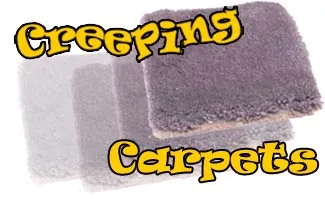 The Teacher's Corner
The Teacher's Corner
Physics Science Experiment
Creeping Carpets
This week's experiment is one that has been "cooking" in my mind for a while now. Today I had carpets on my mind, since I was cleaning them with our new carpet cleaner. We live at the beach, and our carpets tend to get dirty and sandy, so we place small rugs along the pathway that gets the most use. One problem is that the rugs don't stay there. They slowly migrate across the room. How can this happen? Is the cat doing it to drive us crazy? (She would if she thought it would work!) No, the cat is not involved. The movement is due to the interaction between the carpet and the rugs.
To try this, you will need:
- a room with carpet
- a small rug
- tape
- a toothbrush
Place the rug in the middle of a nice, open spot on the carpet. Cut 4 small pieces of tape and place one on the carpet on each corner of the rug. These pieces of tape will help us see whether the rug moves.
Now that you have everything set, watch the rug carefully. Is it moving? I hope not. Unless you have lots of bugs or a haunted house, the rug should not be moving all by itself. To get things going, you have to participate.
Walk back and forth across the rug, making sure to step on it several times. After you have walked across it 4 or 5 times, look at the rug and the pieces of tape. Has it moved? Probably so. This varies, depending on your carpet. The deeper the pile on your carpet, the more the rug will move.
Why does the rug move? Your carpet is made up of lots of long, thin fibers or threads. These fibers form a pattern or "knap" in the carpet and when you push down on them, they all tend to bend in the same direction. When you step onto the rug, all the fibers tend to bend the same way. For our example, we will say that they all bend towards the east side of the room. As the fibers bend, they move the rug with them, so as you step down, the rug moves a fraction of an inch to the east. When you lift your foot, the carpet fibers bend back to their original position, but since there is no pressure on the rug now, they slide across it, leaving it slightly east of its starting point. The next time you step on it, the rug will again move to the east, and soon it winds up out of the path.
An easy way to see this on a larger scale is with a toothbrush. Hold it so that the bristles point upwards, like the fibers of the carpet. Place your finger on top of the bristles of the toothbrush and press downwards. You will find that the as you press your finger downwards, the bristles all bend the same direction and your finger tends to move slightly that way. Lift your finger slowly and you will feel the bristles slide back to their original position. Do this over and over and you will find the your finger tends to "migrate" across the brush, just as the rug does on the carpet. So if your rugs wind up on the wrong side of the room, now you know why. Your cat did it!
 Check out more Science Experiments
Check out more Science Experiments
All lessons are brought to you by The Teacher's Corner and Robert Krampf's Science Education Company.
Robert Krampf's Science Shows thehappyscientist.com